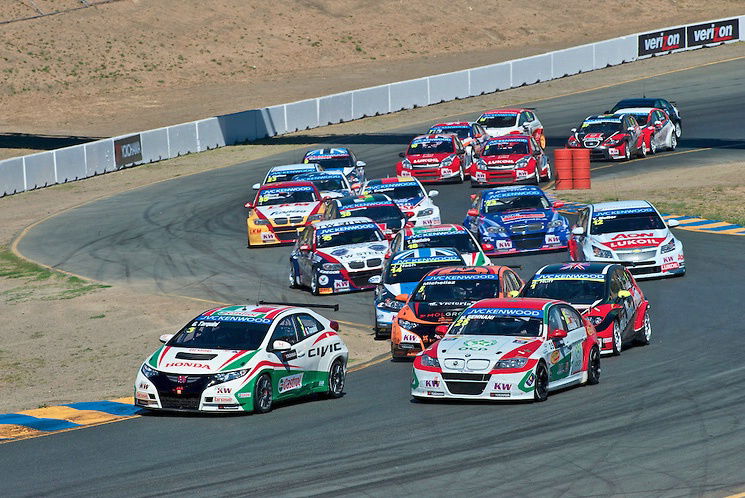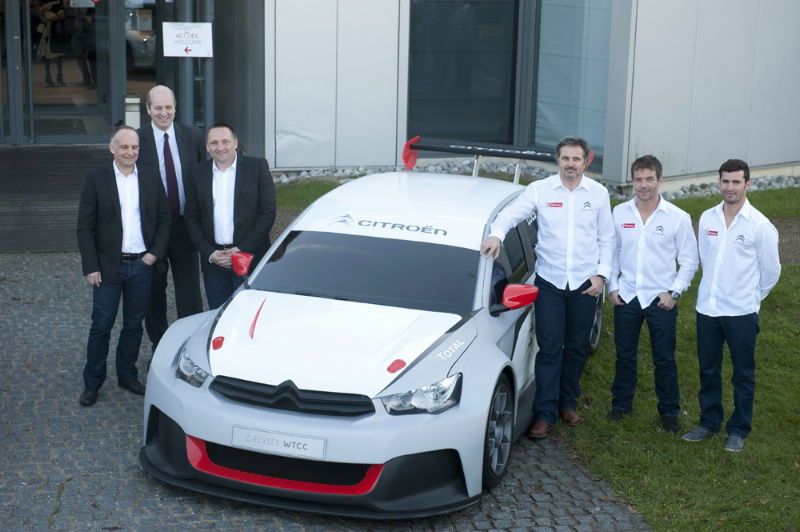How do Yokohama develop WTCC tyres?

2014 sees the first drastic regulation changes in the FIA WTCC since its rebirth from the former European series in 2005. The big changes will be seen with improved engine performance and aerodynamic properties, while the technical regulations will also see tyre sizes grow by an inch.
Wanting to know more about the impact this will have on this year's action, Crash.net's Dexter Fielding spoke to Ian Beveridge at the Autosport International show about the development of tyres over the years and going into the 2014 season, where regulation changes come into force.
Beveridge is one of Yokohama Motorsports' technical consultants and has been working in the FIA WTCC since 2007, a year after the Japanese company became the 'control tyre' for the series.
Q:
Ian, Yokohama have supplied tyres for the championship since 2006: how have you seen development change over these last 8 year?
Ian Beveridge:
In some respects we are limited on what development work we can actually do, that is in effect due to the contract - once you introduce a tyre, it has to stay that way for the contact duration, and so if we have made any mistakes, then you have to live with the consequences of that until the contract has run its course.
Equally with our tenure we have had to make some minor changes to the basic tyre, because changes in legislation don't allow some components in the construction which were in the tyres. Now we are not allowed to use them anymore so we have had to refine and find replacements for those. We have had to make small, very minor modifications just to try and improve the reliability and consistency of the tyre to produce a robust and reliable tyre.
Q:
What is the most important or critical process of tyre development for the series?
Ian Beveridge:
Most important? I think we always look for a consistent product, so one that gives us a reasonable lap time, not necessarily the fastest that we can achieve, but over the course of a race distance will give the competitor a consistent feel. Of course there is always a drop off in performance, but we try and keep that to a minimum, so that racing can continue in a sensible fashion right until the end.
It also means that qualifying is less than a one lap wonder so you can have a second chance, in practicality you don't get that second chance. It's not a disaster if you miss your first lap; you have a second attempt to do that.
So to have a consistent product is one thing but to also make sure it can cope in different climates and conditions throughout the world. We will go from very hot temperatures such as South America to colder and wetter conditions such as Anderstorp in the past which has not been that nice. So the one tyre has to cope with both conditions, we have to be sure that whatever product we turn up with will cope in all conditions on different types of car and still give a good performance - so those are the areas that we concentrate on.
Q:
The regulations are changing drastically this year, so how has Yokohama approached those changes?
Ian Beveridge:
OK, sensibly the FIA consulted us to a degree when they introduced the new set of regulations and so we had an idea of what the changes might be. So using our expertise up-to-date in this series, other formulas and other areas, we were able to say 'with the engine, aero changes and with the forces we see with these types of cars - we think that you would need a tyre of these dimensions.'
So we put forward those dimensions to the FIA and the car manufacturers, which they all accepted (as we hoped they would.) We then went away and produced tyres to those sizes and through a series of tests in various locations and our knowledge in the past, we have developed a tyre and we have a reasonably confident idea of what we think the new car will produce in terms of stresses and strains, and using that knowledge have produced something that we think will cope with different cars and conditions as mentioned earlier.
Q:
What development up until now has taken place for the new tyres this year?
Ian Beveridge:
We initially started designing the new tyres at the end of 2012 and we did our initial testing in early 2013, which involved taking various constructions and compounds and even - to a degree - different shapes of tyre. We had more than one mould shape produced to assess which was the best and with the tests we gradually filter the better ones with more consistent feeling, better for the driver, to produce the best tyre.
It was a bit like the 'process of elimination' we then had a small confirmation test in October last year, SEAT provided us a car with their test driver and we were able to invite the other car manufacturers and engineers came along to witness that test, and actually Gabriele Tarquini drove that car to get a feel of the tyre and to have some experience and also to confirm we hadn't gone up a blind alley. We agreed that the engineers should have data from the test too.
It seems that we gone in a sensible direction and it works quite well - only time will tell once we start racing in the new season, but we are confident that we should see a reasonable life in the tyre and as the cars get faster, so we can also have some room for progression and there is capacity for improvement for both sides.
Q:
How important is the drivers input to the reaction of the tyres?
Ian Beveridge:
The drivers input really is one of the key factors I'd have to say. We have seen that more than one type of tyre can produce a similar laptime round a circuit, but the way the driver has to achieve that can be quite different. So we will find - it may sound silly - a tyre that the driver can race on; in other words, he can change direction easily and make adjustments accordingly. It is meant to be user-friendly, so even though you committed to a line in a corner, you can change direction, modify your line so it becomes a driveable tyre.
We'll pick the tyre which gives the driver a competitive laptime with consistent performance and also a good element of driveability, so when they come to race in a big bunch - which happens a lot in WTCC - they can be competitive and it won't be difficult to race in close proximity. That is one of the key factors from the driving side.
Q:
And lastly, would you make of a 'tyre war' in WTCC, perhaps in the future?
Ian Beveridge:
It is a bit of a double-edged sword I'd have to say.
When you become the sole supplier it is comfortable but equally if things go wrong you are totally responsible. To a degree, the competitors are not always happy to have a tyre forced upon them; you have to be careful to make sure the product copes with all the conditions, which we have managed to do up-to-date.
We are reasonably confident that our last tyre was strong and robust enough and worked well in different conditions.
Some completion... It wouldn't have been a bad thing, but again as soon as you have competition, in terms of equality of performance it become difficult to control, because the WTCC is a series where the cars performance is equalised. If you introduced a different tyre for different cars, that would immediately make that very hard to do.
There is a control tyre in world touring cars to try and balance out that performance to a degree, so no one manufacturer is particularly dominant - that clearly hasn't worked entirely! Without that, it would be even more difficult, so from the FIA's point of view I can see that they need a control tyre to make those situations work.
From a tyre manufacturer's perspective, we wouldn't be uncomfortable competing against other manufacturers. We are competitive animals, we want to race and prove our product is better than another's, which is what motorsport for tyre manufacturers should be all about.
In short - we are happy either way. We understand the need for competition, but equally on the other side of the coin you also to have a consistent product for all competitors, so that is one element of variation of performance which is taken away. It is a little bit difficult to reach a good compromise. That is the situation as I see it.
Q:
Great, thank you very much for taking time out, Ian.
Ian Beveridge:
Not at all, thanks.
by Dexter Fielding

